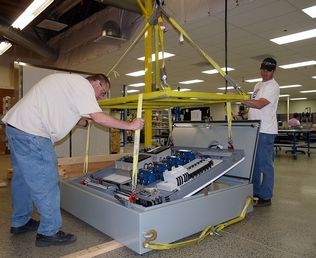By Rachel La Corte, Associated Press
OLYMPIA — Gov. Jay Inslee signed off on an $8.7 billion transportation budget Monday that puts money toward maintaining state roadways and continues spending on existing big-ticket projects.
But he vetoed some sections, including a proposal to spend $81 million planning a replacement bridge that would extend Interstate 5 over the Columbia River.
“There is no wisdom in expending these funds if the state of Washington does not contribute adequate funding to actually build the bridge,” he said before vetoing the section. “We all need to understand a central fact. This project needs to be funded this year. There is no other option.”
The effort to replace the bridge connecting Portland with Vancouver, Wash., has encountered obstacles in the predominantly Republican Washington state Senate, where several members are opposed to the Columbia River Crossing proposal in its current form. They say it is too low and should not include light rail transit, and are concerned about costs.
The $3.4 billion project would include two new double-decker bridges with five travel lanes in each direction — up from three — and space for pedestrians, bicyclists and light-rail trains. Oregon and Washington are each responsible for $450 million, with the federal government and toll revenue paying the rest. Oregon has already approved its portion, but if Washington state does not, the federal match will fall through.
House Transportation Committee Chairwoman Judy Clibborn, D-Mercer Island, said that veto “makes perfect sense to me.”
“Until we have a revenue package, we don’t really know if we’ll need that money,” she said.
Including the bridge planning money, Inslee vetoed a dozen sections of the transportation budget Monday, including a provision for an audit of State Route 520 that Inslee said duplicated work already being done, and a study of guardrails that Inslee said no funding was available for.
The budget does continue funding for the Alaskan Way Viaduct tunnel project in Seattle, a replacement bridge for State Route 520 over Lake Washington and high-occupancy lanes on Interstate 5 in Tacoma.
Inslee said the budget “makes key investments in our transportation system to keep people and goods moving safely and smoothly throughout the state.”
Earlier in the day, Inslee spoke at a rally in support of a funding package for transportation projects.
House Democrats support a proposal to raise the gas tax by 10 cents per gallon to help maintain existing roads, as well as to fund a handful of pending big-ticket projects, but the plan faces skepticism from the Senate majority.
The tax would provide money for connecting State Routes 167 and 509 to Interstate 5, the North Spokane Corridor and the $450 million needed for Washington’s share of the Columbia River Crossing Project.
Washington lawmakers are in the midst of a special legislative session to address a projected deficit of more than $1.2 billion in the next two-year state operating budget, plus a court-ordered increase in funding for the state’s education system, but Inslee has said that transportation funding must be addressed as well.
Most of the $81 million that had been allocated toward the Columbia River Crossing in the transportation budget would have been withheld until the U.S. Coast Guard looked at how the project design would hamper river traffic and navigation.
Sen. Ann Rivers, a Republican from La Center who has been a critic of the current bridge project, said that she was disappointed by the governor’s veto of that section.
“The Legislature worked really hard to give the governor an option, and he just took it off the table,” she said. “We’ve always said we want a project that works.”
Inslee said that the veto of the funding money for the Columbia River Crossing shouldn’t “be taken at all that we can’t move forward.”
“It would be foolish to turn down $850 million in federal money when they recognize we’re going to end up paying more for this project if we don’t do it this year,” Inslee said. “Washington taxpayers will have to shell out more tax dollars to deal with this bridge if we don’t take this option that is available to us today.”
Rivers debated the notion that the federal money was a sure thing.
“I’m not willing to stake the future of our general fund on these major projects,” she said. “I think we have to proceed thoughtfully and thoroughly. Right now we’re operating on a wing and a prayer.”











